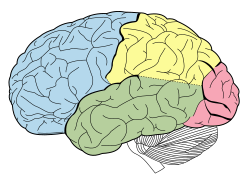User:Lehession/sandbox
Structure[edit]
This section needs additional citations for verification. (March 2012) |

The cerebrum comprises the largest part of the brain. It lies in front or on top of the brainstem and, in humans, is the largest and best-developed of the five major divisions of the brain. The cerebrum is the newest structure in the phylogenetic sense, with mammals having the largest and most developed structures among all species.
The cerebrum is composed of the following regions:[1]
- Cerebral cortex: Layer of grey matter (type of nervous tissue involved in information processing) on the surface of the cerebrum.
- White Matter: Type of nervous tissue involved in relaying signals between grey matter areas.
Cerebral Cortex[edit]

The cerebral cortex, or the lining of gray matter on the cerebrum, is found only in mammals. In larger mammals, including humans, the surface of the cerebral cortex folds to create gyri (ridges) and sulci (furrows). These structural adaptations increases surface area without adding volume, increasing surface-area-to-volume ratio.[2]
The cerebral cortex is generally classified into four areas: the frontal lobe, parietal lobe, temporal lobe, and occipital lobe. The lobes are classified based on their overlying neurocranial bones. [3]
Cerebral Hemispheres[edit]
The cerebrum can be split into two cerebral hemispheres, the right and the left side. The right side of the cerebral hemisphere controls and processes signals from the left side of the body, while the left hemisphere is concerned with the right side of the body. [3] (See: Lateralization of Brain Function for more about the differences between the two cerebral hemispheres.)
Development[edit]
In the developing vertebrate embryo, the neural tube subdivides into four unseparated sections which then develop further into distinct regions of the CNS; these are the prosencephalon, the mesencephalon the rhombencephalon and the spinal cord. The prosencephalon develops further into the telencephalon (forebrain or cerebrum), and the much smaller diencephalon which develops into the optic vessels[citation needed] and the hypothalamus. The telencephalon then forms two lateral telencephalic vesicles which develop into the left and right cerebral hemispheres.
- ^ Arnould-Taylor, William (1998). A Textbook of Anatomy and Physiology. Nelson Thornes. p. 52. Retrieved 27 January 2015.
- ^ Angevine, J.; Cotman, C. (1981). Principles of Neuroanatomy. NY: Oxford University Press.
{{cite book}}:|access-date=requires|url=(help) - ^ a b Rosdahl, Caroline; Kowalski, Mary (2008). Textbook of Basic Nursing (9th ed.). Lippincott Williams & Wilkins. p. 189. Retrieved 28 January 2015.

